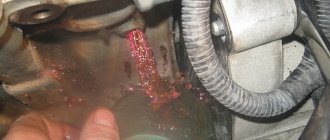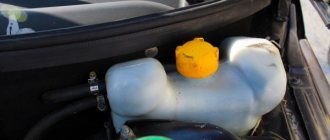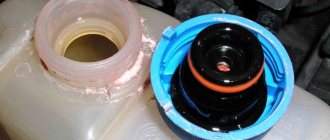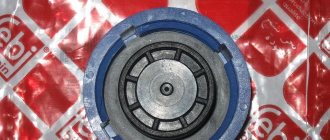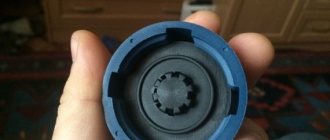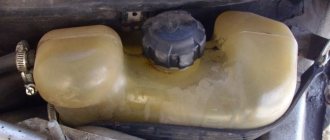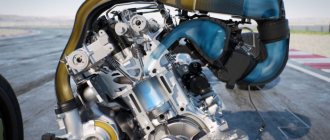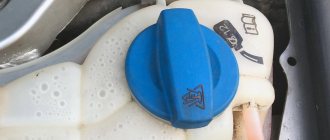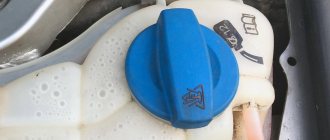Have you noticed that the heater in your car is blowing cold air? There may be several reasons for the problem, but most often this occurs due to the formation of an air lock in the engine cooling system. Next, we will tell you how to remove air from the cooling system of Lada cars (Granta, Kalina, Priora, Largus, Niva, Vesta or XRAY) in several ways.
Let us remind you that AVTOVAZ installs the same type of power units on its models, so the instructions are similar for all Lada cars.
Why does antifreeze eject from the expansion tank or radiator?
Content
- The principle of operation of the expansion tank
- How to identify problems with the cooling system
- Causes of malfunctions
- Remedies
Quite often, car enthusiasts encounter fluid leaks from the engine cooling system. Such a malfunction is not always obvious and sometimes causes difficulties in diagnosis. In this article, we will figure out why antifreeze is thrown out of the expansion tank and why the liquid level can constantly drop to a critical level. It turns out that the problem can be either a minor problem or a serious malfunction of the power unit. In any case, it must be resolved promptly.
SOD components
The cooling system includes many different parts that are responsible for the correct operation of the system. To understand the purpose of these parts, you need to take a closer look at them.
Cooling radiator
This part is designed to cool antifreeze while the car is moving. As coolant circulates through the radiator it cools and therefore cools the engine block. Inside, the radiator consists of many tubes connected to each other by a snake.
Possible breakdowns:
- Antifreeze leaking from radiator joints;
- Radiator clogged with oxidation products;
Water pump (Pump)
The pump is a pump that circulates liquid through the cooling system. Circulation is ensured by the pump impeller based on the principle of centrifugal force. The pump rotates using the crankshaft through the timing belt.
Possible breakdowns:
- Coolant leaks through the oil seal;
- Wear of ball bearings;
- Impeller failure;
Thermostat
The thermostat is one of the main elements of the Priora engine cooling system. Inside the thermostat housing there is a valve with a thermoelement, which is responsible for opening and closing a large circle. When the coolant is heated to a temperature of 85⁰C, the thermostat valve opens and the liquid begins to pass through the cooling radiator, thereby cooling down and preventing the engine from overheating.
Possible breakdowns:
- Valve jamming in one of the positions;
Expansion tank
The expansion tank is designed to compensate for the expansion of the liquid during heating, as well as the contraction during cooling. It is for these reasons that the amount of liquid in the tank is at an average level.
Possible breakdowns:
- Tank rupture due to a breakdown of the cylinder head gasket;
- Cracks in the tank due to old age;
Expansion tank cap
The main task of the tank cap is not only to close the opening of the coolant tank, but also to relieve excess pressure in the system. It is in the lid that a valve is installed that operates in two positions: pressure release and vacuum release (vacuum). If there were no valve, the pressure in the system would inflate the hoses and rupture the expansion tanks.
Possible breakdowns:
- Valve jamming;
- Loss of tightness;
Cooling Fan
Designed to cool the engine in a traffic jam or when the car is stationary. As you know, the radiator effectively cools the car when there is a headwind, that is, when driving. When stuck in a traffic jam, the cooling of the car is reduced to zero, so a fan is used as an artificial wind, which turns on at a certain temperature and cools the liquid.
Possible breakdowns:
- Fan motor malfunction;
Heater radiator
The heater radiator and the cooling radiator have a similar design, but differ in size and purpose. The purpose of the heater radiator is to heat the vehicle interior. It is installed in the stove body in the engine compartment and has two input and output fittings.
Possible breakdowns:
- Leak at joints;
- Blockage;
Pipes
The pipes are responsible for the circulation of fluid from one part to another throughout the system. They are made of rubber that is resistant to temperature loads; inside each pipe there is a reinforced thread that does not allow the pipe to swell due to pressure in the system.
Possible breakdowns:
- Cracks;
- Drying of rubber over time;
We hope our article was useful to you.
Signs of an air lock in the cooling system
Air pockets in the cooling system can cause the engine to overheat.
The first and most important symptom of traffic jams is engine overheating, poor heater performance and fluid leakage.
The cooling system of any engine must maintain tightness . In the old classic carburetor VAZ models, as in other cars of that period, antifreeze was added to the system both through the expansion tank and through the radiator cap. However, with the transition to new technologies, it was possible to improve the tightness of the system and improve its operation.
Therefore, there was no need for a radiator cap. This was largely possible thanks to the use of more advanced antifreezes, which boil and release air at higher temperatures.
Reasons for appearance
The first and main reason for the disruption of coolant circulation through the system is its leakage.
Cooling system of the VAZ-2110 injection engine.
- Flowing through the cracks, the volume will certainly be filled with air, which enters through the expansion tank plug . Next, air bubbles disperse throughout the system and clog it in the most vulnerable places.
- Another reason for the appearance of traffic jams is the boiling of low-quality liquids . When using antifreezes such as Tosol or similar suspicious compounds (basically water stained with blue), the boiling threshold shifts as close as possible to the operating temperature of the engine .
As you know, water boils at approximately 100°C and this leads to the active release of steam. And the fan on the VAZ-2110 only turns on at a liquid temperature of about 100°C. Hence the appearance of air in the system and “overheating without overheating.” Any good antifreeze calmly holds temperatures up to 130-150 ° C without releasing steam (pure ethylene glycol boils at a temperature of under 200 degrees). It is for this reason that plugs so often appear in the cooling system among those who like to save on antifreeze.
In short, yes. Now we will remove the consequences of saving or breaking the tightness of the system.
Symptoms
Symptoms or signs of airiness are not difficult to recognize. To do this, you just need to pay attention to the uncharacteristic behavior of your vehicle.
Although sometimes it happens that the driver, calmly operating his car, does not even suspect that a harmful air plug has long ago formed inside the cooling system. Signs of such a malfunction are as follows:
- The thermostat breaks. When the fan turns on almost immediately after starting the engine, there is probably a problem in the system. Air sometimes accumulates in the pipes, which provokes circulation only along the internal circuit of the cooling jacket;
- The coolant temperature indicator arrow is in the zero position, even when the engine is warmed up;
- There is a coolant leak. Look under the car to see if there are traces of coolant. This will also help determine where exactly the leak is;
- The engine overheats with enviable regularity. This symptom indicates impaired circulation;
- When the pump operates, extraneous noise occurs;
- The stove is not working properly. It’s not a fact that the reason is precisely airing. But it's worth checking.
If you observe one or more of the symptoms presented, you should check the operation of the cooling system. If you have a new and good foreign car, I don’t recommend going there with your own hands. But everyone decides for themselves.
Plus, keep an eye on the dashboard icons for signals. They will tell you if the engine is overheating, and more.
Causes
Since everything is clear with the signs, you can move on to the reasons why your injector may experience airing in the cooling system.
There is no point in fixing the problem until its causes have been identified. Otherwise, you can disassemble half the machine without achieving the desired result. And it doesn’t matter whether you have a Gazelle, a new Solaris or some Mercedes S-Class.
Airing often occurs due to:
- depressurization;
- incorrect addition of coolant;
- malfunction of the air valve;
- formation of suction due to the pump;
- cooling fluid leaks;
- mechanical damage to system elements;
- normal wear and tear;
- failure of the cylinder head gasket;
- incorrectly performed previous repairs.
Having dealt with the source of the trouble, you first need to get rid of the cause of the airiness. And only then you should proceed directly to the procedure for removing the airlock.
If you were unable to figure out the reasons on your own, it is better not to continue to study the ins and outs of your vehicle on your own. Contact a good car service center, where specialists, using professional and precise equipment, will carry out all the necessary diagnostic measures.
Consequences
If an air lock is detected in the automotive cooling system of an 8-cl engine or any other engine, there is no point in postponing repairs until later.
Since the circulation of cooling fluid in the car is disrupted, very soon the engine itself and all associated equipment will begin to suffer. The engine will not cool properly, and operating the car at elevated temperatures leads to extremely rapid wear of the elements.
There is one additional problem that does not seem so serious. But only before the cold weather sets in. If the system becomes airy, the stove will not be able to properly heat the interior. And therefore you will be very cold.
Additionally, an air lock leads to increased fuel consumption, breakdown of various sensors, and overheating. As a result, everything ends with a major overhaul. Believe me, removing the air is much easier and cheaper than repairing the engine.
How to remove air from the cooling system of a VAZ Kalina
VAZ 2110 Kalina how to remove an air lock from the cooling system
In cold weather, owners of viburnum often begin to have problems with the operation of the stove at idle speed. For example, when you warm up the car, the engine temperature is already rising, and cold air is still blowing from the heater; when the gas is turned on, the heater begins to blow warm or hot air with the characteristic murmur of water under the instrument panel. These symptoms indicate that there is air in the engine cooling system.
Air enters the system mainly due to leaky connections of the pipes, as well as incorrect operation of the expansion tank plug.
What to do before removing the plug
First of all, you need to understand why an air lock forms, for this:
- We check for coolant leaks in the connections of the pipes, if there are any, we tighten the clamps or replace them.
- We check the coolant level in the expansion tank; for viburnums, it is advisable to keep the level at or slightly above the maximum.
- We check the correct operation of the expansion tank plug; if the air inlet plug does not work or with noticeable difficulty, then it is better to replace it; below I will explain in more detail about the plug.
- It is also advisable to check whether the interior heater radiator is leaking; this can be done from inside the cabin by removing the right lower side of the panel under your feet and feeling the floors and the heater block itself.
There are 2 main ways:
- Works on all families of Viburnum cars: stand with your face on a good slope, unscrew the cap of the expansion tank and warm up the car until the fan operates. After the radiators and engine have completely warmed up, a trickle of coolant will flow through the return into the expansion tank, if it doesn’t work you need to gas it. We constantly monitor the structure of the incoming liquid; if it foams and there are clearly bubbles in it, then we continue further until coolant flows without air. This procedure takes about 20-30 minutes.
- We remove the plug using the pipes going to the throttle assembly; those with an electronic gas pedal are not suitable. In this option, we leave the switched off car to stand for a certain time so that the air rises to the highest point, namely to the throttle assembly. After this, we unscrew one of the pipes and, holding one of the holes (on the throttle or the hose itself), blow into the expansion tank until coolant flows out without air, after that we plug the hole and carry out the same operation on the other. After two operations, we quickly connect everything back so that no air gets in.
General recommendations for prevention
The first thing you should pay attention to is the level of antifreeze in the cooling system. Always check and top up if necessary. Also, if you need to add coolant very frequently, this is the first call that indicates something is wrong with the system and further diagnostics are needed to determine the cause of the problem. Also check for antifreeze leaks. It is best to do this in a viewing hole.
Try using the antifreeze recommended by the vehicle manufacturer. And make purchases in trusted authorized stores, minimizing the likelihood of purchasing a counterfeit. The fact is that a low-quality coolant during the repeated heating process can gradually evaporate and instead an air chamber forms in the system. Therefore, you should not neglect the manufacturer’s requirements.
Instead of a conclusion
Finally, I would like to note that if the described signs of system ventilation appear, it is necessary to carry out diagnostics and testing as soon as possible. After all, the air chamber significantly reduces the efficiency of the cooling system. For this reason, the engine operates under conditions of increased wear, which can lead to premature failure. Therefore, try to get rid of the plug as soon as possible if you find any air bubbles. Fortunately, even a novice car enthusiast can do this, since the procedure is simple and does not require the use of any additional tools or devices.
Good afternoon. I would like to know how to remove the plug from the cooling system. I replaced the heater radiator, tried to climb the mountain, throttled at 2-3 thousand rpm until the fan started working, after which I slowly opened the expansion tank cap. Maybe he went through this procedure a little?) Priores with E-gas.
Comments 60
Why does air come out of the oven when turning left?
I have been tormented by this problem for a long time, the solution turned out to be much simpler than it seems, it is unclear how the heater radiator hose became clogged, which, in order to release air, was carefully blown out with a compressor, and everything worked, as I discovered in theory, if you blow into the expansion tank After unscrewing the hose I said it should be coming out of the main radiator and then it was coming out of the main radiator and it was impossible to blow out of the furnace. I unscrewed this hose and unscrewed the cap on the expansion tank with a regular car compressor, blew it out (carefully at low pressure) until bubbles appeared in the expansion tank, then checked everything in the reverse order, that is, I blew it into the tank from the hose, went into standby mode, reconnected everything and voila everything is working
There should also be no traffic jams in the previous traffic. The other day I changed the radiator, Halla Conder, Luzar radiator, but it looks like 1in1. I didn’t pinch any of the pipes, filled it with antifreeze and didn’t heat it up. It's hot in the car again)
I have a Priora with Hala, there are NO problems with replacing the heater radiator! Everything is much simpler than Panas or without a condo. Previously, there could not have been caps, I ate the dog on this topic, not so long ago the heater was blowing hot, the engine heated up from 90 to 102 in 5 minutes, I changed the antifreeze, the pump, the thermostat, it was already up to the heater radiator and it was clogged, I took it off, at home it was stupid under the tap with citric acid, of course it was necessary to leave it overnight, but the car is needed every day, in the end the stove got so hot that it burned my hand, I endured it, up to 93g in the car Tashkent, but a week passed and it got worse, that is, it’s hot but not Tashkent, Maybe they actually took such a radiator, if at first everything was fine, then the radiator is 100% and therefore beware of trains, do not overtighten the RB cover.
Maybe the radiator is sucked in) okay, I'll try to change it)
A year after installing the radiator, Luzar broke along its entire length. We ate and drove it into the garage for a replacement. He floated like a smoke bomb. Initially it warms up and does not freeze, after replacing it with Daazovsky I immediately felt the difference!
I have a Priora with Hala, there are NO problems with replacing the heater radiator! Everything is much simpler than Panas or without a condo. Previously, there could not have been caps, I ate the dog on this topic, not so long ago the heater was blowing hot, the engine heated up from 90 to 102 in 5 minutes, I changed the antifreeze, the pump, the thermostat, it was already up to the heater radiator and it was clogged, I took it off, at home it was stupid under the tap with citric acid, of course it was necessary to leave it overnight, but the car is needed every day, in the end the stove got so hot that it burned my hand, I endured it, up to 93g in the car Tashkent, but a week passed and it got worse, that is, it’s hot but not Tashkent, Maybe they actually took such a radiator, if at first everything was fine, then the radiator is 100% and therefore beware of trains, do not overtighten the RB cover.
Hello, can you tell me how often I can change the hoses of my Panasonic Prior heater? To lose less antifreeze, how to drain?
This is how you read the comments and don’t want to ask anything else, I recommend it to everyone here. So even with foam at the mouth they will prove their nonsense. Someone wrote such a blizzard! The system itself will clean all the air from the system. The main thing is to warm up to the opening temperature of the thermostat, and all the air will come out by itself. There is no need to drive, blow or squeeze pipes on any slope.
What kind of nonsense are they not writing? Look at the nozzles at the outlet of the stove; if it’s hot, the radiator is bad. In Priora, traffic jams go away in the blink of an eye, for peace of mind you go up a little hill and slow down a little and that’s it.
Priora, whether gas engine or mechanical throttle, does not have the problem of an air chamber in the cooling system. This is not Samara or Kalina, there is such a thing. If you did everything correctly, add antifreeze and go ahead. You can add a maximum of 300 grams and then it will go away, and therefore this is very rare. If it ventilates the system, it's time to think about gases getting into the cooling system. Most likely it was overheating. See if the antifreeze is leaving or not.
The highest point in the cooling system is the throttle valve. If air accumulates, it means that it is in the throttle valve heating circuit. The rest comes naturally. To speed up the process, you can squeeze the tubes after opening the thermostat.
Not relevant, the person wrote that they have E-gas. Electronic gas is not heated
It's a pity…
